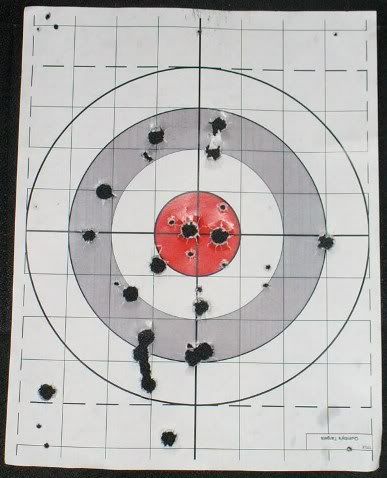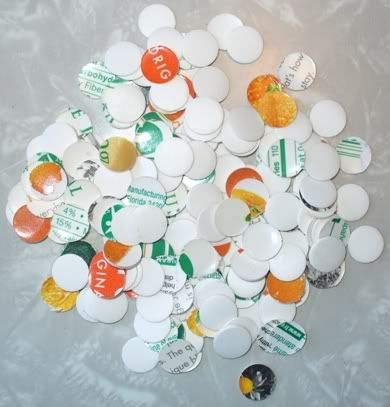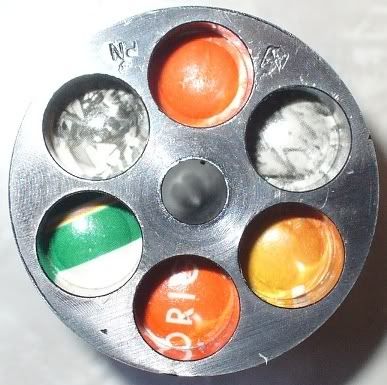arcticap
54 Cal.
I went to the range Sunday with a new container of 777 3F to try in my Remington 1858 for the first time. I loaded 25 grains with an over powder card and tried not to compress it as much as I usually do when loading with APP 3F.
Early on during the first 6 full cylinders were one or two misfires which I figured were simply due to using some older Remington Golden #11 caps, even though I haven't had any trouble with ignition previously using them with APP.
However on the 7th full cylinder after loading as normal, I experienced a strange string of 6 ignition problems in a row.
Those last 6 shots consisted of 3 misfires and 3 squib loads. All 3 squib loads were expelled but not strong enough to reach the target at 12 yards.
I removed the cylinder without recapping and found that the balls were missing from all 6 chambers, even the 3 that had misfired.
Those chambers still had the over powder cards in them, however the cards were moved forward and were offset.
Looking under the cards, I was surprised to find that those 3 chambers were still fully loaded with powder. I ended up dumping the 777 on the ground while showing my shooting partner how they were still full.
The nipples weren't clogged or else the balls would have never been expelled by the misfires.
And for some reason, the troubles happened to all 6 chambers on the same 7th full cylinder, and all in a row.
I thought that this was strange enough to label as an anomoly because what are the chances of ignition trouble affecting every chamber at the same time?
The setting on my Triple P loader was left in the same position as most of the other full cylinders that I had previously loaded.
Maybe the powder was compressed too much. The fffg is a superfine powder granulation, and it was only sitting in the flask for less than an hour or two on a comfortably cool day. So I don't think that it went bad that fast.
It worked fine up until that point and the targets were fairly good, especially the last 18 shots up until the last cylinder full. (See below)
I was very surprised to see that the #11 caps were strong enough to expel the balls in the 3 chambers that misfired. I'm pretty sure that's directly attributable to the fairly tight fitting over powder cards that I punch out using a die. They retained enough of the expanding gas from the percussion cap to push the ball out yet the flame was not hot enough to ignite the 777.
I really don't intend to use 777 in my Remington anymore, at least not on a regular basis. It occurred to me afterward that any one of those last 6 shots could have become lodged in the barrel. Fortunately none of them did become lodged and no harm was done.
I've never had any notable ignition problem using 777 in other any other guns before. The powder shot fine up until that point, but the Triple P loading press that I use invites compressing the powder. I really didn't think that a little compression would hurt. Especially after the fairly accurate results of the 4th, 5th and 6th full cylinders of balls.
777 would probably benefit from using a booster charge to help insure ignition, or hotter or magnum caps. Perhaps this was all due to my loading method, or the Golden caps, or the nipples becoming more constricted with residue. But I would rather load with APP than to have a repeat of what happened today by loading this Pietta Remington with 777.
In hindsight, I should have used the newer Remington Green caps and not the older Remington Golden caps.

Early on during the first 6 full cylinders were one or two misfires which I figured were simply due to using some older Remington Golden #11 caps, even though I haven't had any trouble with ignition previously using them with APP.
However on the 7th full cylinder after loading as normal, I experienced a strange string of 6 ignition problems in a row.
Those last 6 shots consisted of 3 misfires and 3 squib loads. All 3 squib loads were expelled but not strong enough to reach the target at 12 yards.
I removed the cylinder without recapping and found that the balls were missing from all 6 chambers, even the 3 that had misfired.
Those chambers still had the over powder cards in them, however the cards were moved forward and were offset.
Looking under the cards, I was surprised to find that those 3 chambers were still fully loaded with powder. I ended up dumping the 777 on the ground while showing my shooting partner how they were still full.
The nipples weren't clogged or else the balls would have never been expelled by the misfires.
And for some reason, the troubles happened to all 6 chambers on the same 7th full cylinder, and all in a row.
I thought that this was strange enough to label as an anomoly because what are the chances of ignition trouble affecting every chamber at the same time?
The setting on my Triple P loader was left in the same position as most of the other full cylinders that I had previously loaded.
Maybe the powder was compressed too much. The fffg is a superfine powder granulation, and it was only sitting in the flask for less than an hour or two on a comfortably cool day. So I don't think that it went bad that fast.
It worked fine up until that point and the targets were fairly good, especially the last 18 shots up until the last cylinder full. (See below)
I was very surprised to see that the #11 caps were strong enough to expel the balls in the 3 chambers that misfired. I'm pretty sure that's directly attributable to the fairly tight fitting over powder cards that I punch out using a die. They retained enough of the expanding gas from the percussion cap to push the ball out yet the flame was not hot enough to ignite the 777.
I really don't intend to use 777 in my Remington anymore, at least not on a regular basis. It occurred to me afterward that any one of those last 6 shots could have become lodged in the barrel. Fortunately none of them did become lodged and no harm was done.
I've never had any notable ignition problem using 777 in other any other guns before. The powder shot fine up until that point, but the Triple P loading press that I use invites compressing the powder. I really didn't think that a little compression would hurt. Especially after the fairly accurate results of the 4th, 5th and 6th full cylinders of balls.
777 would probably benefit from using a booster charge to help insure ignition, or hotter or magnum caps. Perhaps this was all due to my loading method, or the Golden caps, or the nipples becoming more constricted with residue. But I would rather load with APP than to have a repeat of what happened today by loading this Pietta Remington with 777.
In hindsight, I should have used the newer Remington Green caps and not the older Remington Golden caps.









